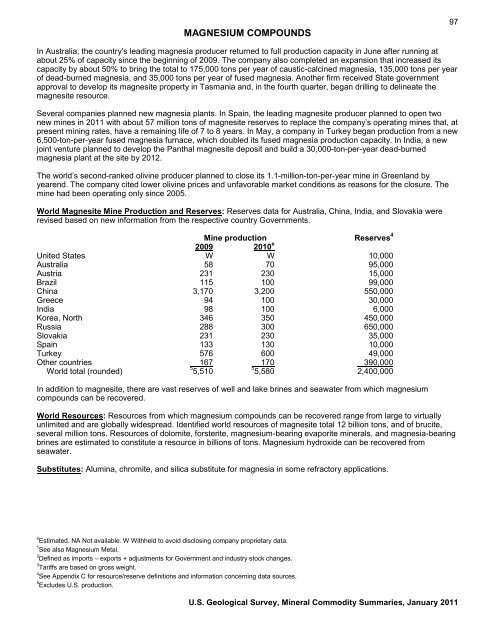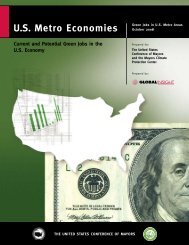MAGNESIUM COMPOUNDS97In Australia, the country’s leading magnesia producer returned to full production capacity in June after running atabout 25% of capacity since the beginning of 2009. The company also completed an expansion that increased itscapacity by about 50% to bring the total to 175,000 tons per year of caustic-calcined magnesia, 135,000 tons per yearof dead-burned magnesia, <strong>and</strong> 35,000 tons per year of fused magnesia. Another firm received State governmentapproval to develop its magnesite property in Tasmania <strong>and</strong>, in the fourth quarter, began drilling to delineate themagnesite resource.Several companies planned new magnesia plants. In Spain, the leading magnesite producer planned to open twonew mines in <strong>2011</strong> with about 57 million tons of magnesite reserves to replace the company’s operating mines that, atpresent mining rates, have a remaining life of 7 to 8 years. In May, a company in Turkey began production from a new6,500-ton-per-year fused magnesia furnace, which doubled its fused magnesia production capacity. In India, a newjoint venture planned to develop the Panthal magnesite deposit <strong>and</strong> build a 30,000-ton-per-year dead-burnedmagnesia plant at the site by 2012.The world’s second-ranked olivine producer planned to close its 1.1-million-ton-per-year mine in Greenl<strong>and</strong> byyearend. The company cited lower olivine prices <strong>and</strong> unfavorable market conditions as reasons for the closure. Themine had been operating only since 2005.World Magnesite Mine Production <strong>and</strong> Reserves: Reserves data for Australia, China, India, <strong>and</strong> Slovakia wererevised based on new information from the respective country Governments.Mine production Reserves 420092010 eUnited States W W 10,000Australia 58 70 95,000Austria 231 230 15,000Brazil 115 100 99,000China 3,170 3,200 550,000Greece 94 100 30,000India 98 100 6,000Korea, North 346 350 450,000Russia 288 300 650,000Slovakia 231 230 35,000Spain 133 130 10,000Turkey 576 600 49,000Other countries 167 170390,000World total (rounded)5,5105,580 2,400,000In addition to magnesite, there are vast reserves of well <strong>and</strong> lake brines <strong>and</strong> seawater from which magnesiumcompounds can be recovered.World Resources: Resources from which magnesium compounds can be recovered range from large to virtuallyunlimited <strong>and</strong> are globally widespread. Identified world resources of magnesite total 12 billion tons, <strong>and</strong> of brucite,several million tons. Resources of dolomite, forsterite, magnesium-bearing evaporite minerals, <strong>and</strong> magnesia-bearingbrines are estimated to constitute a resource in billions of tons. Magnesium hydroxide can be recovered fromseawater.Substitutes: Alumina, chromite, <strong>and</strong> silica substitute for magnesia in some refractory applications.e Estimated. NA Not available. W Withheld to avoid disclosing company proprietary data.1 See also Magnesium Metal.2 Defined as imports – exports + adjustments for Government <strong>and</strong> industry stock changes.3 Tariffs are based on gross weight.4 See Appendix C for resource/reserve definitions <strong>and</strong> information concerning data sources.5 Excludes U.S. production.U.S. Geological Survey, <strong>Mineral</strong> <strong>Commodity</strong> <strong>Summaries</strong>, January <strong>2011</strong>
98MAGNESIUM METAL 1(Data in thous<strong>and</strong> metric tons unless otherwise noted)Domestic Production <strong>and</strong> Use: In 2010, magnesium was produced by one company at a plant in Utah by anelectrolytic process that recovered magnesium from brines from the Great Salt Lake. Magnesium used as aconstituent of aluminum-based alloys that were used for packaging, transportation, <strong>and</strong> other applications was theleading use for primary magnesium, accounting for 41% of primary metal use. Structural uses of magnesium(castings <strong>and</strong> wrought products) accounted for 32% of primary metal consumption. Desulfurization of iron <strong>and</strong> steelaccounted for 13% of U.S. consumption of primary metal, <strong>and</strong> other uses were 14%.Salient Statistics—United States: 2006 2007 2008 2009 2010 eProduction:Primary W W W W WSecondary (new <strong>and</strong> old scrap) 82 84 84 67 70Imports for consumption 75 72 83 47 50Exports 12 15 14 20 16Consumption:Reported, primary 78 72 65 51 55Apparent12013014090100Price, yearend:Platts Metals Week, U.S. spot Western,dollars per pound, average 1.40 2.25 3.15 2.30 2.60Metal Bulletin, China free market,dollars per metric ton, average 2,050 4,550 2,800 2,740 3,100Stocks, producer <strong>and</strong> consumer, yearend W W W W WEmployment, number e 400 400 400 400 400Net import reliance 4 as a percentage ofapparent consumption 53 47 50 33 34Recycling: In 2010, about 20,000 tons of secondary production was recovered from old scrap.Import Sources (2006–09): Canada, 36%; Israel, 25%; China, 11%; Russia, 8%; <strong>and</strong> other, 20%.Tariff: Item Number Normal Trade Relations12-31-10Unwrought metal 8104.11.0000 8.0% ad val.Unwrought alloys 8104.19.0000 6.5% ad val.Wrought metal 8104.90.0000 14.8¢/kg on Mg content + 3.5% ad val.Depletion Allowance: Dolomite, 14% (Domestic <strong>and</strong> foreign); magnesium chloride (from brine wells), 5% (Domestic<strong>and</strong> foreign).Government Stockpile: None.Events, Trends, <strong>and</strong> Issues: In October, the U.S. Department of Commerce, International Trade Administration(ITA), made a final determination of antidumping duties for imports of pure magnesium from China into the UnitedStates for May 1, 2008, through April 30, 2009. The ITA determined a duty of 0% ad valorem for one company <strong>and</strong> aChina-wide duty of 111.73% ad valorem, the same as the China-wide rate had been since the 2007–08 review. In itsfinal review of primary magnesium shipments to the United States from Russia from April 1, 2008, through March 31,2009, the ITA determined that the dumping rate for one of the two Russian primary magnesium producers was 0% advalorem. For the other, even though the company did not sell material into the United States during the period ofreview, the ITA determined that if any material from the company had entered the United States through another firm,it would be subject to the “all others” rate of duty established at the time that it was imported into the United States.Normally, if a company had not made any sales into the U.S. market, the antidumping duty would be rescinded. TheITA also completed an expedited 5-year sunset review of magnesium alloy imports from China <strong>and</strong> pure <strong>and</strong> alloymagnesium imports from Russia into the United States. Because no party in the original determination notified the ITAthat it intended to participate in the reviews, the ITA determined that revocation of the antidumping orders would likelylead to a continuation of dumping. As a result, the ITA maintained the antidumping duty orders. For alloy magnesiumfrom China, two companies had a duty of 49.66% ad valorem, <strong>and</strong> the China-wide duty was 141.49% ad valorem. Forpure <strong>and</strong> alloy magnesium from Russia, one primary magnesium-producing firm had a duty of 21.71% ad valorem,the other had a duty of 18.65% ad valorem, <strong>and</strong> the Russia-wide rate was 21.01% ad valorem.Prepared by Deborah A. Kramer [(703) 648-7719, dkramer@usgs.gov, fax: (703) 648-7757]
- Page 3:
U.S. Department of the InteriorKEN
- Page 6 and 7:
INTRODUCTION3Each chapter of the 20
- Page 8 and 9:
5NET EXPORTS OF MINERALRAW MATERIAL
- Page 10 and 11:
SIGNIFICANT EVENTS, TRENDS, AND ISS
- Page 12 and 13:
mineral materials valued at $1.30 b
- Page 14 and 15:
11MAJOR METAL-PRODUCING AREASAuB2P1
- Page 16 and 17:
13MAJOR INDUSTRIAL MINERAL-PRODUCIN
- Page 18 and 19:
ABRASIVES (MANUFACTURED)15Events, T
- Page 20 and 21:
ALUMINUM17The United States continu
- Page 22 and 23:
ANTIMONY19Events, Trends, and Issue
- Page 24 and 25:
ARSENIC21According to university me
- Page 26 and 27:
ASBESTOS23Events, Trends, and Issue
- Page 28 and 29:
BARITE25Nationally, the rig count o
- Page 30 and 31:
BAUXITE AND ALUMINA27Events, Trends
- Page 32 and 33:
BERYLLIUM29Events, Trends, and Issu
- Page 34 and 35:
BISMUTH31Events, Trends, and Issues
- Page 36 and 37:
BORON33Events, Trends, and Issues:
- Page 38 and 39:
BROMINE35Events, Trends, and Issues
- Page 40 and 41:
CADMIUM37NiCd battery use in consum
- Page 42 and 43:
CEMENT39The manufacture of clinker
- Page 44 and 45:
CESIUM41Events, Trends, and Issues:
- Page 46 and 47:
CHROMIUM43Stockpile Status—9-30-1
- Page 48 and 49:
CLAYS45Tariff: Item Number Normal T
- Page 50 and 51: COBALT47Events, Trends, and Issues:
- Page 52 and 53: COPPER49Events, Trends, and Issues:
- Page 54 and 55: DIAMOND (INDUSTRIAL)51Events, Trend
- Page 56 and 57: DIATOMITE53Events, Trends, and Issu
- Page 58 and 59: FELDSPAR55Feldspar use in tile and
- Page 60 and 61: FLUORSPAR57with planned output of 1
- Page 62 and 63: GALLIUM59In response to the unprece
- Page 64 and 65: GARNET (INDUSTRIAL)61Events, Trends
- Page 66 and 67: GEMSTONES63Events, Trends, and Issu
- Page 68 and 69: GERMANIUM65Events, Trends, and Issu
- Page 70 and 71: GOLD67With the increase in price of
- Page 72 and 73: GRAPHITE (NATURAL)69Events, Trends,
- Page 74 and 75: GYPSUM71Through 2010, more than 3,6
- Page 76 and 77: HELIUM73Events, Trends, and Issues:
- Page 78 and 79: INDIUM75China’s 21 indium produce
- Page 80 and 81: IODINE77Events, Trends, and Issues:
- Page 82 and 83: IRON AND STEEL79Events, Trends, and
- Page 84 and 85: IRON AND STEEL SCRAP81Tariff: Item
- Page 86 and 87: IRON AND STEEL SLAG83Events, Trends
- Page 88 and 89: IRON ORE85In 2009, China imported a
- Page 90 and 91: IRON OXIDE PIGMENTS87Events, Trends
- Page 92 and 93: KYANITE AND RELATED MATERIALS89Even
- Page 94 and 95: LEAD91caused by underground fires a
- Page 96 and 97: LIME93The lime industry is facing p
- Page 98 and 99: LITHIUM95market, and a facility at
- Page 102 and 103: MAGNESIUM METAL99U.S. magnesium con
- Page 104 and 105: MANGANESE101Government Stockpile:St
- Page 106 and 107: MERCURY103Events, Trends, and Issue
- Page 108 and 109: MICA (NATURAL)105Depletion Allowanc
- Page 110 and 111: MOLYBDENUM107Events, Trends, and Is
- Page 112 and 113: NICKEL109Nickel prices were adverse
- Page 114 and 115: NIOBIUM (COLUMBIUM)111Events, Trend
- Page 116 and 117: NITROGEN (FIXED)—AMMONIA113Accord
- Page 118 and 119: PEAT115Events, Trends, and Issues:
- Page 120 and 121: PERLITE117Events, Trends, and Issue
- Page 122 and 123: PHOSPHATE ROCK119Events, Trends, an
- Page 124 and 125: PLATINUM-GROUP METALS121Events, Tre
- Page 126 and 127: POTASH123Events, Trends, and Issues
- Page 128 and 129: PUMICE AND PUMICITE125Events, Trend
- Page 130 and 131: QUARTZ CRYSTAL (INDUSTRIAL)127Event
- Page 132 and 133: RARE EARTHS129Events, Trends, and I
- Page 134 and 135: RHENIUM131Events, Trends, and Issue
- Page 136 and 137: RUBIDIUM133Events, Trends, and Issu
- Page 138 and 139: SALT135Many chefs have advocated us
- Page 140 and 141: SAND AND GRAVEL (CONSTRUCTION)137Ev
- Page 142 and 143: SAND AND GRAVEL (INDUSTRIAL)139The
- Page 144 and 145: SCANDIUM141Scandium’s use in meta
- Page 146 and 147: SELENIUM143Events, Trends, and Issu
- Page 148 and 149: SILICON145Events, Trends, and Issue
- Page 150 and 151:
SILVER147Silver was used as a repla
- Page 152 and 153:
SODA ASH149A Wyoming soda ash produ
- Page 154 and 155:
SODIUM SULFATE151Events, Trends, an
- Page 156 and 157:
STONE (CRUSHED)153Events, Trends, a
- Page 158 and 159:
STONE (DIMENSION)155Events, Trends,
- Page 160 and 161:
STRONTIUM157Events, Trends, and Iss
- Page 162 and 163:
SULFUR159World sulfur production in
- Page 164 and 165:
TALC AND PYROPHYLLITE161Events, Tre
- Page 166 and 167:
TANTALUM163Events, Trends, and Issu
- Page 168 and 169:
TELLURIUM165Events, Trends, and Iss
- Page 170:
THALLIUM167Beginning in 2009, there
- Page 173 and 174:
170TIN(Data in metric tons of tin c
- Page 175 and 176:
172TITANIUM AND TITANIUM DIOXIDE 1(
- Page 177 and 178:
174TITANIUM MINERAL CONCENTRATES 1(
- Page 179 and 180:
176TUNGSTEN(Data in metric tons of
- Page 181 and 182:
178VANADIUM(Data in metric tons of
- Page 183 and 184:
180VERMICULITE(Data in thousand met
- Page 185 and 186:
182WOLLASTONITE(Data in metric tons
- Page 187 and 188:
184YTTRIUM 1(Data in metric tons of
- Page 189 and 190:
186ZEOLITES (NATURAL)(Data in metri
- Page 191 and 192:
188ZINC(Data in thousand metric ton
- Page 193 and 194:
190ZIRCONIUM AND HAFNIUM(Data in me
- Page 195 and 196:
192APPENDIX AAbbreviations and Unit
- Page 197 and 198:
194Demonstrated.—A term for the s
- Page 199 and 200:
196Part B—Sources of Reserves Dat
- Page 201:
198Europe and Central Eurasia—con







